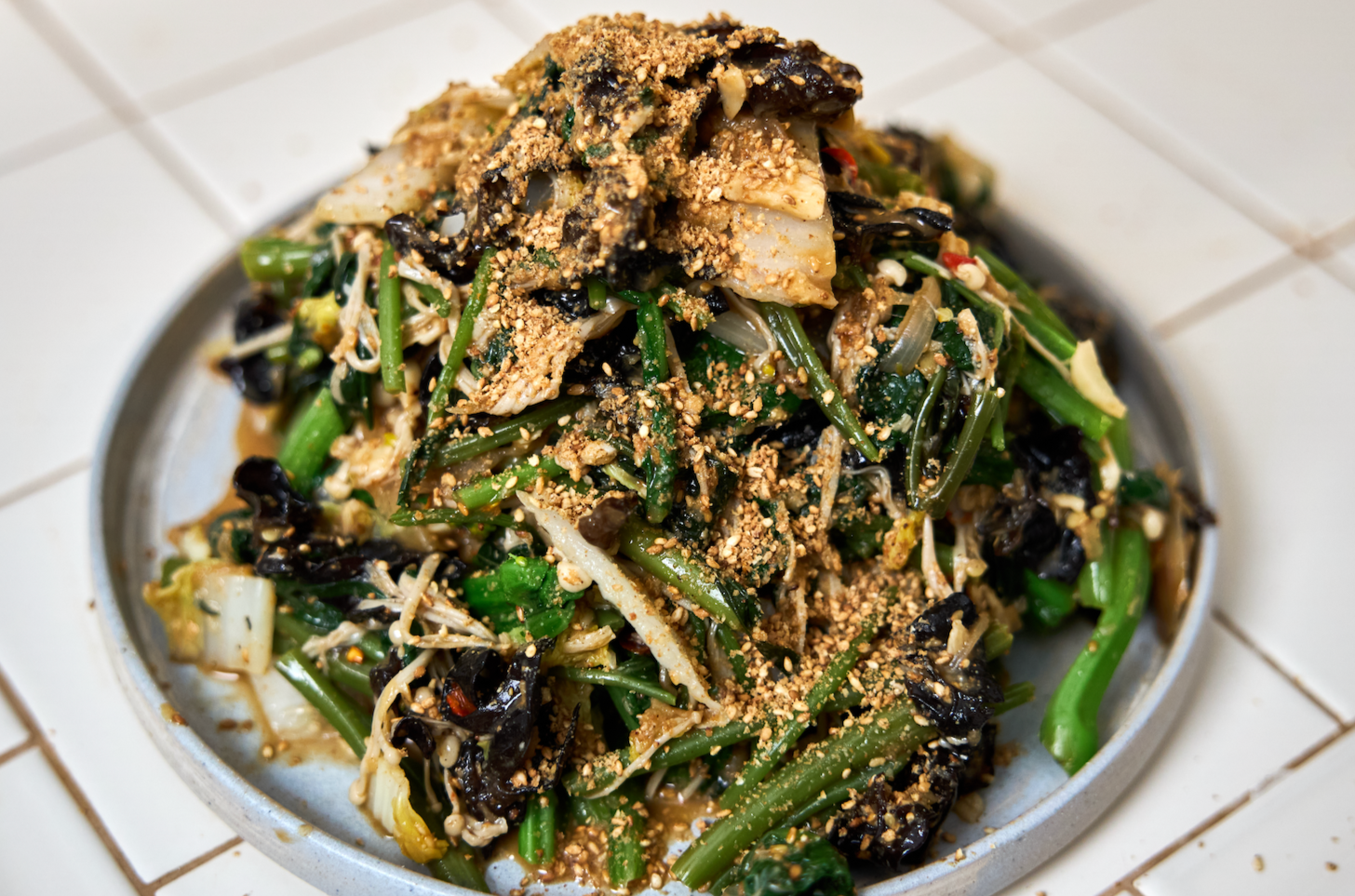How to cook a Turkey (Lao Style & Dry Brine Method)
What is a Lao turkey recipe?
What makes this turkey extra special is the combination of flavors and techniques that create its glistening, crispy skin and tender meat, perfectly suited to the Lao palette. Inspired by Lao cuisine’s love for BBQ and grilled whole chicken, the seasoning and spices bring those bold, smoky flavors to this Thanksgiving centerpiece.
Since turkey is much larger than chicken, a dry brine method was used. This approach is ideal for those with smaller fridges, as it skips the bulky process of wet brining. The dry brine, featuring Lao BBQ spice blend, not only tenderizes the meat but also helps dry out the skin, ensuring it crisps beautifully during roasting.
On the bottom of the pan, there will be a delicious aromatic broth made from lemongrass and lime leaves and it can be turned into a gravy.
For the finishing touch, the turkey is brushed with a savory oyster and fish sauce glaze, enhancing its flavor and giving it a golden, glossy finish.
Ingredients Needed for Lao Turkey
turkey: buy a frozen turkey and let it thaw compeletly; this could take a few days so plan ahead.
coarse sea salt: make sure it is course as that helps massage into the turkey skin.
Lao Spices BBQ blend: this provides all the Lao aromatics like lemongrass, galangal, lime leaves, and coriander.
brown sugar: gives it that sweetness similar to palm sugar.
baking powder: helps break down the turkey skin causing it to crisp and brown better.
Lemongrass: fresh lemongrass to add the fragrance to the pan broth
Kaffir Lime leaves: fresh leaves to add the fragrance to the pan broth
yellow onion: cut up onions to add the fragrance to the pan broth
Ginger: fresh ginger to add the fragrance to the pan broth
puffed sticky rice: makes a great gluten free alternative to for stuffing.
Garlic: adds more flavor.
Oyster sauce: used to give the skin roasted bbq flavor.
Fish sauce: adds the extra umami to the skin flavor.
golden seasoning sauce: adds the extra umami to the skin flavor.
roasted sesame oil: adds the extra umami to the skin flavor.
granulated sugar: adds the extra umami to the skin flavor and helps it brown.
How to Dry Brine
Thaw and Pat Dry: To prepare your turkey, start by planning ahead. You’ll need at least a week before cooking day to ensure enough time for thawing and seasoning. A frozen turkey requires 24 hours to thaw for every 5 pounds, so a 14-pound turkey will take about 3 full days. Once the turkey is completely thawed, pat it dry thoroughly with paper towels, including the cavity, to remove any excess moisture.
Salt and Season: For seasoning, don’t skimp on salt—it may seem like a lot, but a 14-pound turkey needs plenty of seasoning to penetrate the meat and skin. Mix your dry brine with salt, a bit of sugar to balance the saltiness, and baking powder, which helps break down the skin for a crispier finish. You can customize the spices, but a Lao BBQ spice blend works wonderfully here.
Apply and Massage: Once your seasoning is ready, rub it all over the dry turkey, massaging it into the skin until it begins to feel slightly wet and sticks. Be thorough, covering the wings, drumsticks, back, and even under the skin near the breast. The thick breast skin should hold up well as you gently massage the seasoning underneath. Don’t forget to sprinkle some seasoning inside the cavity. Use all the seasoning for full flavor.
Fridge time: Place the seasoned turkey on a roasting pan with a rack. This allows excess moisture to drip off, helping the skin dry out. While some suggest dry brining for 24 hours, 32–48 hours is ideal for better flavor and tenderness. By the end of the process, the skin should be dry and ready for roasting. Before cooking, clean out the pan to remove any excess salt that dripped off during the brining.
How to Roast a Whole Turkey
Pat Dry and Flip Turkey: There are numerous methods for cooking a Thanksgiving turkey, but the approach I'm about to share has consistently worked for me since my childhood, inspired by my mother's technique. When using this turkey and dry brine method, it's important to lightly pat the turkey dry after taking it out of the fridge and before placing it in the oven. Position the turkey breast-side down; this enables the juices to flow more effectively.
Cover with Foil: Preheat your oven to 450°F and let it warm for 15 minutes. Cover the turkey and the roasting pan with aluminum foil; this maintains moisture and allows the turkey to cook in its own steam. After the turkey is covered and ready, reduce the heat to 325°F. A general rule of thumb is to cook for 15 minutes per pound, so for a 14-pound turkey, you should expect a cooking time of approximately 3 hours and 30 minutes.
Glaze and Repeat: At the halfway mark, carefully remove the turkey from the oven, taking off the aluminum foil. Using two wooden kitchen utensils to avoid burns, flip the turkey so the breast side is up. At this point, begin brushing the glaze over the turkey, applying a light coat as you will repeat this process several more times. After brushing, return the turkey to the oven, and repeat the glazing process after 30 minutes. As the internal temperature approaches 165°F, increase the frequency of the glazing to every 15 minutes to ensure a minimum of three coats.
Rest the Bird: By the end of the cooking time, the turkey's skin should be a beautiful dark golden brown. Take as many pictures as you'd like, but avoid cutting into the turkey immediately after removing it from the oven. Instead, carefully lift the turkey out using the rack and place it on a tray to let the turkey rest for 30 minutes. This resting period allows the juices to redistribute, ensuring that all parts reach a safe temperature of 165°F. The skin should remain crispy and intact.
How to Carve a Turkey
Having an uncarved turkey on the dinner table can create a striking presentation, but cutting into it can lead to a mess with juices spilling everywhere. To avoid this, it’s best to remove the turkey after everyone has taken their photos and carve it in a location where spills won’t be an issue.
When carving a turkey, utilize a sharp knife and follow the natural lines on the bird. Start by removing the legs — cut down the thighs until you reach the bone, then bend the legs slightly to expose the cartilage and cut through it. After the legs are removed, proceed to the wings; pull each wing until the cartilage is visible and then cut.
Next, focus on the large breast. Start your cut straight down the middle but slightly favoring one side, and continue cutting near the breastbone until you can easily remove an entire half of the breast in one piece. Once you have the breast, slice it into serving pieces so everyone can enjoy some.
Don’t forget to separate the wings from the drumettes and the drumsticks from the thighs. Plate the carved turkey nicely and garnish it with edible herbs and peppers for an appealing presentation.
Can you spatchcock this turkey?
I’ve used the same turkey recipe for years, but recently I started spatchcocking the bird — and it completely changed the game. Spatchcocking helps the turkey cook more evenly, cuts down the overall cook time, and makes it much easier to spread the marinade over every part of the bird.
To spatchcock the turkey, place it breast-side down so the backbone is facing you. Using sharp kitchen shears, cut along one side of the spine, then repeat on the other side to remove it. Flip the turkey over and press down firmly to flatten it. Some people also remove the wishbone to help it lay even flatter. Set the turkey on a large baking sheet fitted with a wire rack so air circulates underneath and the juices can drip below.
After the turkey has finished brining, roast it in a preheated 450°F oven for 30 minutes, then glaze it. Reduce the heat to 325°F and continue glazing every 30 minutes. The total cook time is usually between 1 hour 30 minutes and 2 hours. Use a thermometer to ensure the thickest part of the breast reaches 165°F. Once done, remove the turkey from the oven, tent it loosely with foil, and let it rest for 30 minutes before carving.






















Sabaidee, I’m Saeng!
I’m a personal chef who specializes in Lao food. Here at Saeng’s Kitchen, you’ll find all your favorite traditional Lao foods and also some new twists to Lao style dishes.